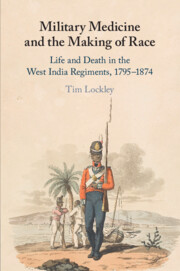Book contents
- Military Medicine and the Making of Race
- Military Medicine and the Making of Race
- Copyright page
- Dedication
- Contents
- Figures and Tables
- Acknowledgements
- Introduction
- 1 Medical Necessity and the Founding of the West India Regiments
- 2 The Ideal Soldier
- 3 The Use and Abuse of the Black Soldier
- 4 Statistics and the Reinterpretation of Black Bodies
- 5 Dehumanising the Black Soldier
- 6 Damage Done: The Asante Campaigns
- Conclusion
- Bibliography
- Index
Introduction
Published online by Cambridge University Press: 13 March 2020
- Military Medicine and the Making of Race
- Military Medicine and the Making of Race
- Copyright page
- Dedication
- Contents
- Figures and Tables
- Acknowledgements
- Introduction
- 1 Medical Necessity and the Founding of the West India Regiments
- 2 The Ideal Soldier
- 3 The Use and Abuse of the Black Soldier
- 4 Statistics and the Reinterpretation of Black Bodies
- 5 Dehumanising the Black Soldier
- 6 Damage Done: The Asante Campaigns
- Conclusion
- Bibliography
- Index
Summary
The introduction sets out the main themes of the book and establishes the context from which the West India Regiments emerged in the late eighteenth century. The British had successfully expanded their control in the Caribbean during the eighteenth century even though mortality in the army remained stubbornly high. On some campaigns enslaved people had been used in short-term auxiliary military roles, setting a precedent that would be followed to its logical conclusion after 1795. Slavery remained the bedrock of Caribbean society, and while racial concepts remained somewhat in flux during the eighteenth century, they were gradually hardening. West Indian physicians, however, generally agreed that black and white bodies were fundamentally the same.
- Type
- Chapter
- Information
- Military Medicine and the Making of RaceLife and Death in the West India Regiments, 1795–1874, pp. 1 - 18Publisher: Cambridge University PressPrint publication year: 2020

